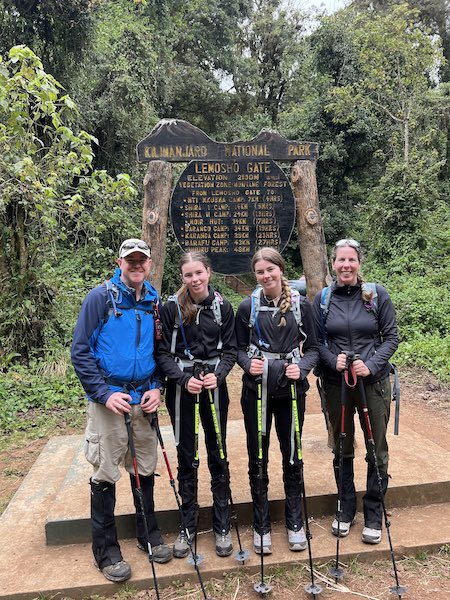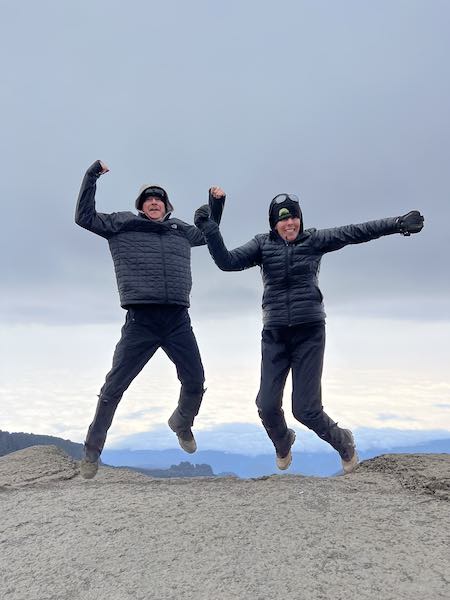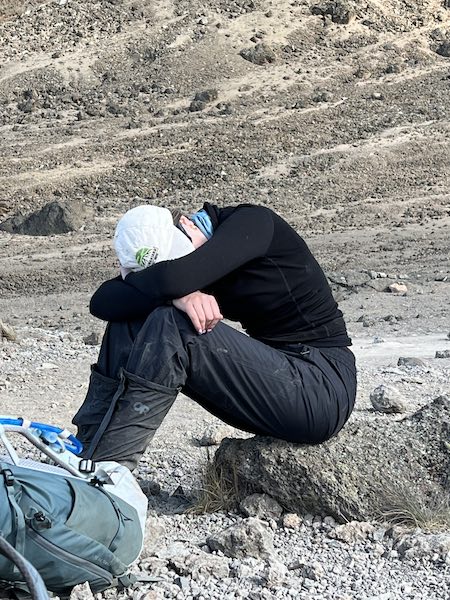Scarsdale Family Scales Mount Kilimanjaro, “The Roof of Africa”
- Sunday, 17 September 2023 17:50
- Last Updated: Sunday, 17 September 2023 19:50
- Published: Sunday, 17 September 2023 17:50
- Joanne Wallenstein
- Hits: 3186
 Paquins at the summit – Africa’s highest point – Elevation: 19,341 feetWhile most Scarsdale families spent their summer vacation at a beach, lake or the Scarsdale Pool, the Paquin family set their sights on a far more ambitious plan: to climb Africa’s highest peak, Mount Kilimanjaro in Tanzania.
Paquins at the summit – Africa’s highest point – Elevation: 19,341 feetWhile most Scarsdale families spent their summer vacation at a beach, lake or the Scarsdale Pool, the Paquin family set their sights on a far more ambitious plan: to climb Africa’s highest peak, Mount Kilimanjaro in Tanzania.
Here is their story as written by 16 year-old Chloe Paquin followed by an interview with her mother, Claire.
Reflections of a Non-Hiker. By Chloe Paquin
Please don’t get the wrong idea. We are not a hiking family. If you had told us all ten years ago that we would successfully summit the tallest mountain in Africa, not one of us would have believed you. But that is when this plan was hatched.
Ten years ago, when my dad turned 40 years old, he decided to celebrate his birthday by finding a physical challenge to set him on the right fitness path for the rest of his life. As a former Division 1 ice hockey player, his athletic drive was too intense for him to be satisfied by simply working out in the gym. He wanted something more. So, he gathered a group of friends and, along with my mom, they began training to climb the Grand Teton in Wyoming. Shortly after their successful summit, he climbed Longs Peak. Then came Mount Washington, Mount Whitney, Mount Fuji, Mount Rainier, and Castle Peak. But still, it was not enough and so his new dream was born: climb Mount Kilimanjaro, the tallest mountain in Africa and one of the Seven Summits, and do it with his family by his side to celebrate his 50th birthday.
As much as my dad talked about climbing Mount Kilimanjaro over the last decade, we never thought it would actually happen. When I was six years old and my younger sister, Ursie, was four, we didn’t know what he was talking about. We couldn’t even pronounce the name of the mountain. It wasn’t until a decade later when my mom started procuring tons of hideous hiking gear for me and Ursie, that we realized this was real. But even then, it felt so far away. Until it wasn’t. The moment we had all been dreading - well, with the exception of my dad who has been annoyingly enthusiastic about this whole thing - was finally here.
“Is everyone ready?” our guide inquires, probably rhetorically, but I answer anyway, “Not even close, but let’s go.” Our eight-day long hike of the Lemosho Route begins in the woods. We walk for hours and hours up and down hills, each one a small mountain that we must conquer on our way to the true summit. As we labor our way forward, we are continually reminded by the guides and porters that we need to go “pole pole” which means slowly in Swahili. After climbing Kilimanjaro countless times, they no longer need to take their own advice, and we are reminded of this each time they speed by us. We are going pole pole in our newly procured hiking boots and they are flying past us in everything from mismatched Crocs to destroyed oxfords to ruined running sneakers. All while carrying 30 pounds of gear on their heads. It’s somewhat embarrassing. We are struggling and they are swiftly running past us not breaking a sweat. Paquins (JP, Ursie, Chloe, Claire) at the Lemosho Gate – the start of the climb of Mount Kilimanjaro.
Paquins (JP, Ursie, Chloe, Claire) at the Lemosho Gate – the start of the climb of Mount Kilimanjaro.
Eventually, we reach the Mkubwa forest camp and it is time to rest until the sun rises the next morning and we are back at it, one step at a time, slowly moving closer to our goal, which right now, seems unreachable.
Days pass like this. Day one: Mti Mkubwa Camp. Day two: Shira One Camp. Day three: Moir Hut. Day four: Barranco Camp. Day five: Karanga Camp. It’s torture.
On day six, the imposing mountain rests peacefully in front of us, far enough that we are engulfed in discouragement and hopelessness, but close enough that we can discern the image of a sleeping woman, her curves outlined in stone. Peaceful and impossible. She is resting. We are not. And will not for at least two days. As the sun rises in front of us, the moon sets behind us, simultaneously. A feeling of renewal burns within me as the sun illuminates my face. My discouragement fades away along with the night. We can do this.
“I can’t do this,” I say to our guide. Every ounce of hope I had this morning is gone. We have been walking straight uphill for four hours in the scorching heat, and we still have two more hours until we reach camp. The trees are gone. We are surrounded by dirt, dust, and lava rocks. The last remaining vegetation dissipated days ago, as did our will to continue. But we must. We have come too far. Going back now would be like erasing time. The last six days would be meaningless.
Tonight is summit night. We leave from Barafu Camp. Fifteen hours later we will be in the exact same spot. But feeling completely different.
One step in front of another is a simple mantra. For us, it’s not that simple. When I was six years old, being 16 years old seemed unattainable. Like a time that would never come. Just like the mountain: vast, surreal, distant. But now, it feels closer and more reachable. In only a few hours, we will have conquered it.
Those were the longest few hours of my life. Even under my six layers of thick clothing and the puffiest jacket you could imagine, I am frozen. My hair is an icicle, pressed up against the side of my face, and my fingers are numb. Our guide told us earlier that we “may not be able to feel our legs” on the way up. I wish this were the case. Instead, I feel pain and fatigue with every step. I force myself to keep moving, even though every muscle in my body is begging me to stop. As I am staring at the ground, blocking out everything and everyone, watching my feet reluctantly take step after step, I hear my sister let out an immense sigh of relief. I pick my head up and read the sign: Congratulations you are now at Uhuru Peak, Tanzania, 19,341 ft, Africa’s highest point. We did it. It’s hard not to smile.
 Ursie (left) and Chloe (right) resting during a break on a long day’s hike.I crack a smile and then it hits me. We have to go down. We had climbed 4,010 vertical feet on the final ascent from Barafu Camp. Now our guide is telling us we are going all the way down to Mweka Camp. Today. That’s 9,200 vertical feet down. One day, 13,210 vertical feet of hell.
Ursie (left) and Chloe (right) resting during a break on a long day’s hike.I crack a smile and then it hits me. We have to go down. We had climbed 4,010 vertical feet on the final ascent from Barafu Camp. Now our guide is telling us we are going all the way down to Mweka Camp. Today. That’s 9,200 vertical feet down. One day, 13,210 vertical feet of hell.
The porters sprint past us. They are flying towards home as I lunge and absorb my full body weight through my feet, knees, thighs, and hips with every step. The pain of the descent and an 18-hour summit day radiating through my muscles and bones.
In the end, we did it. I did it. Through sheer will and perseverance, not hiking prowess, we attained what appeared initially impossible. I feel accomplished. I’m proud that my family endured and fulfilled my dad’s dream together. It feels so good that we made him happy. But don’t expect me to do it again. Because I am not a hiker. Or maybe I am.
Claire's Take
In order to learn more about the logistics of traveling to Tanzania and climbing Mount Kilimanjaro, we spoke to Chloe’s mother, Claire Paquin.
Not your usual summer vacation, the trip required research, planning and training. As it was Claire’s husband JP’s dream to climb the peak with their daughters, ages 16 and 14, he took the lead on investigating guide companies that could shepherd them on the climb. He decided on Abercrombie and Kent, who provided the guides and even a cook, to lead the family of four up the mountain.
And how to prepare for the journey? Ursula, a freshman, and Chloe, a junior at SHS are both varsity athletes so they had their youth and strength on their side, but did they have the motivation to make the arduous climb? Though Claire and her husband, JP, had done some major hikes, the girls were entirely new to hiking. The family went on a few local hikes to test out their hiking boots and get an idea of how it might feel to spend the day on foot and carrying a hiking pack.
Getting to Tanzania from New York was a challenge in itself. In order to reach Kilimanjaro, the Paquins first boarded a 13 hour flight to Doha, Qatar. Once in the Middle East, they transferred to another 9 hour flight to Kilimanjaro International Airport, then another hour car ride to Arusha, Tanzania. Paquin says, that including the transfer time in the airport, it took 36 hours to travel from their home in Scarsdale to their destination.
In order to get acclimated, the family spent two nights in Arusha. The first was spent touring the area and learning the history of a rare gem called Tanzanite, which is only found in mines at the foothills of Mount Kilimanjaro. On the second day, their guides took them on a prep hike to assess their level of fitness and to see how capable they were. An unexpected bonus that day was that the plains of Mount Meru were filled with wildlife including buffalo, giraffes, warthogs, and baboons. A government ranger, with a rifle on his shoulder, accompanied them that day to protect them from the wild animals. The family felt like they worked a small safari into the trip. JP & Claire jumping for SheJumps
JP & Claire jumping for SheJumps
The next day, after a briefing by the head guide and a comprehensive gear check, they were off on their eight day adventure. Paquin says that the climbing was manageable but that the altitude can be debilitating for some. Fortunately, the family took Diamox, drank tons of water, and spent a lot of time hiking between 14,000 and 15,500 feet so were not sickened by the altitude.
On the first five days of the trip, they began their days at 5 am, with breakfast prepared by the cook at 6 – and a 7 am departure.
They wore multiple layers of clothing and peeled them off during the six to eight hours of climbing per day. On most days, they climbed all morning, and by mid-afternoon were resting at their next camp. Though the altitude kills your appetite, they were instructed to eat as much as possible at each meal – as at those heights “you’re burning calories like crazy,” said Paquin. Their chef, named “Good Luck,” prepared delicious soups and curries and was even able to accommodate a picky eater, making French fries and pizza for the teens.
Water was provided by the guides who collected water from the streams, treated it, and supplied it to the hikers who carried five liters in their pack at the start of every day – a three-liter Camelback and two one-liter Nalgene bottles. Water was essential to combatting altitude sickness so it was imperative to always be drinking and have plenty for each day’s hike.
 One of the girls has had enough!
One of the girls has had enough!
Temperatures dipped into the twenties and thirties at night and the guides gave them hot water bottles to warm their sleeping bags. Tents were erected each night and they slept in their clothes and hats. During the day, conditions on the trail were extremely dusty - and red clay dust covered their clothes and got into the air they breathed. The guide often wore buffs covering their mouths to protect themselves from inhaling too much dust.
But the first 5 days were just preparation for the toughest part of the trip, an 18-hour summit day. Paquin said, “On day six, we climbed 4-5 hours to Barafu Camp which is at 15,330 feet. We had lunch and slept. We were awoken for dinner, slept again, and then ate breakfast at 10 pm that night. At 11:30 pm, we left for a seven-hour climb through the night and reached the peak at 6:30am, just as the sun was rising.”
The sense of relief and excitement when they got to the summit was palpable. Everyone else around them was smiling and cheering, so excited that they had succeeded in climbing Mount Kilimanjaro, one of the Seven Summits, the highest mountain in Africa, often referred to as the “Roof of Africa.” The Paquins hugged and kissed each other and hugged their guides, too. Paquin said there was no way they could have accomplished it without the support and help of the guides.
From the summit elevation of 19,341 feet, they then down-climbed until 1 pm, rested for an hour, ate again, and then hiked down for another five hours. She said, “In one 18-hour period, we climbed up 4,010 feet and down over 9,000 feet. It was absolutely exhausting. My entire body was shaking after the effort.”
Though the weather had been sunny and dry for the most part, on the day they reached the top, the rain started making the descent wet, muddy, and slippery.
The four of them succeeded without injury, fulfilling their JP’s dream to reach the summit together. When they got back to Arusha, they were reunited with the clean clothing they had stored at the hotel and spent two more days in Africa on Safari at the Ngorongoro Crater and in the Serengeti National Park.
Claire said the kids were strong-willed and stoic and that they all feel very proud that they were able to achieve this together. She says, “Once you accomplish something like this, no one can ever take it away from you.”
Claire Paquin runs the award winning interior design firm, Clean Design Partners, www.cleandesignpartners.com. In conjunction with her trip to Mount Kilimanjaro, she raised funds for the non-profit, SheJumps, whose mission is to increase the participation of women and girls in outdoor activities to foster confidence, leadership, and connection to nature and community.








